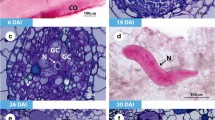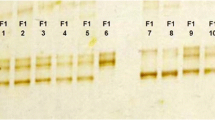Abstract
The emergence of virulent root-knot nematode populations, able to overcome the resistance conferred by some of the resistance genes (R-genes) in Solanaceous crops, i.e., Mi(s) in tomato, Me(s) in pepper, may constitute a severe limitation to their use in the field. Research has been conducted to evaluate the durability of these R-genes, by comparing the reproduction of several laboratory-selected and wild virulent Meloidogyne incognita isolates, on both susceptible and resistant tomatoes and peppers. We first show that the Me1 R-gene in pepper behaves as a robust R-gene controlling avirulent and virulent Me3, Me7 or Mi-1 isolates. Although the reproductive potential of the virulent isolates was highly variable on susceptible and resistant plants, we also confirm that virulence is highly specific to a determined R-gene on which selection has occurred. Another significant experimental result is the observation that a reproductive fitness cost is associated with nematode virulence against Mi-1 in tomato and Me3 and Me7 in pepper. The adaptative significance of trade-offs between selected characters and fitness-related traits, suggests that, although the resistance can be broken, it may be preserved in some conditions if the virulent nematodes are counter-selected in susceptible plants. All these results have important consequences for the management of plant resistance in the field.


Similar content being viewed by others
References
Ayme, V., Petit-Pierre, J., Souche, S., Palloix, A., & Moury, B. (2007). Molecular dissection of the potato virus Y VPg virulence factor reveals complex adaptations to the pvr2 resistance allelic series in pepper. Journal of General Virology, 88, 1594–1601.
Berthou, F., Palloix, A., & Mugniery, D. (2003). Characterisation of virulence in populations of Meloidogyne chitwoodi and evidence for a resistance gene in pepper Capsicum annuum L. line PM217. Nematology, 5, 383–390.
Bleve-Zacheo, T., Bongiovanni, M., Melillo, M. T., & Castagnone-Sereno, P. (1998). The pepper resistance genes Me1 and Me3 induce differential penetration rates and temporal sequences of root cell ultrastructural changes upon nematode infection. Plant Science, 133, 79–90.
Blok, V. C., Jones, J. T., Phillips, M. S., & Trudgill, D. L. (2008). Parasitism genes and host range disparities in biotrophic nematodes: the conundrum of polyphagy versus specialisation. BioEssays, 30, 249–259.
Castagnone-Sereno, P. (2002). Genetic variability of nematodes: a threat to the durability of plant resistance genes? Euphytica, 124, 193–199.
Castagnone-Sereno, P., Bongiovanni, M., & Dalmasso, A. (1994a). Reproduction of virulent isolates of Meloidogyne incognita on susceptible and Mi-resistant tomato. Journal of Nematology, 26, 324–328.
Castagnone-Sereno, P., Wajnberg, E., Bongiovanni, M., Leroy, F., & Dalmasso, A. (1994b). Genetic variation in Meloidogyne incognita virulence against the tomato Mi resistance gene: Evidence from isofemale line selection studies. Theoretical and Applied Genetics, 88, 749–753.
Castagnone-Sereno, P., Bongiovanni, M., Palloix, A., & Dalmasso, A. (1996). Selection for Meloidogyne incognita virulence against resistance genes from tomato and pepper and specificity of the virulence/resistance determinants. European Journal of Plant Pathology, 102, 585–590.
Castagnone-Sereno, P., Bongiovanni, M., & Djian-Caporalino, C. (2001). New data on the specificity of the root-knot nematode resistance genes Me1 and Me3 in pepper. Plant Breeding, 120, 429–433.
Castagnone-Sereno, P., Bongiovanni, M., & Wajnberg, E. (2007). Selection and parasite evolution: a reproductive fitness cost associated with virulence in the parthenogenetic nematode Meloidogyne incognita. Evolutionary Ecology, 21, 259–270.
Cortada, L., Sorribas, F. J., Ornat, C., Kaloshian, I., & Verdejo-Lucas, S. (2008). Variability in infection and reproduction of Meloidogyne javanica on tomato rootstocks with the Mi resistance gene. Plant Pathology, 57, 1125–1135.
Dalmasso, A., & Bergé, J. B. (1978). Molecular polymorphism and phylogenetic relationship in some Meloidogyne spp.: Application to the taxonomy of Meloidogyne. Journal of Nematology, 10, 323–332.
Desbiez, C., Gal-On, A., Girard, M., Wipf-Scheibel, C., & Lecoq, H. (2003). Increase in Zucchini yellow mosaic virus symptom severity in tolerant zucchini cultivars is related to a point mutation in P3 protein and is associated with a loss of relative fitness on susceptible plants. Phytopathology, 93, 1478–1484.
Devran, Z., & Söğüt, M. A. (2010). Occurrence of virulent root-knot nematode isolates on tomatoes bearing the Mi gene in protected vegetable-growing areas of Turkey. Phytopathology Mediterranea, 38, 245–251.
Djian-Caporalino, C., Pijarowski, L., Januel, A., Lefebvre, V., Daubeze, A., Palloix, A., et al. (1999). Spectrum of resistance to root-knot nematodes and inheritance of heat-stable resistance in pepper (Capsicum annuum L.). Theoretical and Applied Genetics, 99, 496–502.
Djian-Caporalino, C., Pijarowski, L., Fazari, A., Samson, M., Gaveau, L., O’Byrne, C. V., et al. (2001). High-resolution genetic mapping of the pepper (Capsicum annuum L.) resistance loci Me3 and Me4 conferring heat-stable resistance to root-knot nematodes (Meloidogyne spp.). Theoretical and Applied Genetics, 103, 592–600.
Djian-Caporalino, C., Fazari, A., Arguel, M. J., Vernie, T., VandeCasteele, C., Faure, I., et al. (2007). Root-knot nematode (Meloidogyne spp.) Me resistance genes in pepper (Capsicum annuum L.) are clustered on the P9 chromosome. Theoretical and Applied Genetics, 114, 473–486.
Dumas de Vaulx, R., Chambonnet, D., & Pochard, E. (1981). Culture in vitro d'anthères de piment (Capsicum annuum): amélioration des taux d'obtention de plantes chez différents génotypes par des traitements à +35°C. Agronomie, 1(10), 859–864.
Hendy, H., Pochard, E., & Dalmasso, A. (1985). Transmission héréditaire de la résistance aux nématodes Meloidogyne Chitwood (Tylenchida) portée par deux lignées de Capsicum annuum L.: étude de descendances homozygotes issues d'androgenèse. Agronomie, 5, 93–100.
Huang, X., McGiffen, M., & Kaloshian, I. (2004). Reproduction of Mi-virulent Meloidogyne incognita isolates on Lycopersicon spp. Journal of Nematology, 36, 69–75.
Jacquet, M., Bongiovanni, M., Martinez, M., Verschave, P., Wajnberg, E., & Castagnone-Sereno, P. (2005). Variation in resistance to the root-knot nematode Meloidogyne incognita in tomato genotypes bearing the Mi gene. Plant Pathology, 54, 93–99.
Janzac, B., Fabre, F., Palloix, A., & Moury, B. (2009). Constraints on evolution of virus avirulence factors predict the durability of corresponding plant resistances. Molecular Plant Pathology, 10, 599–610.
Jarquin-Barberena, H., Dalmasso, A., de Guiran, G., & Cardin, M. C. (1991). Acquired virulence in the plant parasitic nematode Meloidogyne incognita. I. Biological analysis of the phenomenon. Revue de Nématologie, 14(2), 299–303.
Laterrot, H. (1975). Séries de lignées isogéniques de tomate ne différant que par certains gènes de résistance aux maladies. Phytopathologia Mediterranea, 14, 129–130.
Lopez-Perez, J. A., Le Strange, M., Kaloshian, I., & Ploeg, A. T. (2006). Differential response of Mi gene-resistant tomato rootstocks to root-knot nematodes (Meloidogyne incognita). Crop Protection, 25, 382–388.
Meher, H. C., Gajbhiye, V. T., Chawla, G., & Singh, G. (2009). Virulence development and genetic polymorphism in Meloidogyne incognita (Kofoid & White) Chitwood after prolonged exposure to sublethal concentrations of nematicides and continuous growing of resistant tomato cultivars. Pest Management Science, 65, 1201–1207.
Methyl Bromide Technical Options Committee (2006). Report of the Methyl Bromide Technical Options Committee. Non-chemical Alternatives Adopted as Replacements to Methyl Bromide on a Large Scale. Nairobi, Kenya: United Nation Environmental Programme, UNON Publishing Section Services, 39–73.
Ornat, C., Verdejo-Lucas, S., & Sorribas, F. J. (2001). A population of Meloidogyne javanica in Spain virulent to the Mi resistance gene in tomato. Plant Disease, 85, 271–276.
Palloix, A., Ayme, V., & Moury, B. (2009). Durability of plant major resistance genes to pathogens depends on the genetic background, experimental evidence and consequences for breeding strategies. New Phytologist, 183, 190–199.
Parlevliet, J. E. (2002). Durability of resistance against fungal, bacterial and viral pathogens; present situation. Euphytica, 124, 147–156.
Pegard, A., Brizzard, G., Fazari, A., Soucaze, O., Abad, P., & Djian-Caporalino, C. (2005). Histological characterization of resistance to different root-knot nematode species related to phenolics accumulation in Capsicum annuum L. Phytopathology, 95, 158–165.
Petrillo, M. D., & Roberts, P. A. (2005). Fitness of virulent Meloidogyne incognita isolates on susceptible and resistant cowpea. Journal of Nematology, 37, 457–466.
Roberts, P. A. (1995). Conceptual and practical aspects of variability in root-knot nematodes related to host plant resistance. Annual Review of Phytopathology, 33, 199–221.
Roberts, P. A., Dalmasso, A., Cap, G. B., & Castagnone-Sereno, P. (1990). Resistance in Lycopersicon peruvianum to isolates of Mi gene-compatible Meloidogyne populations. Journal of Nematology, 22, 585–589.
Sorribas, F. J., Ornat, C., Verdejo-Lucas, S., Galeano, M., & Valero, J. (2005). Effectiveness and profitability of the Mi-resistant tomatoes to control root-knot nematodes. European Journal of Plant Pathology, 111, 29–38.
Tzortzakakis, E. A., Trudgill, D. L., & Phillips, M. S. (1998). Evidence for a dosage effect of the Mi gene on partially virulent isolates of Meloidogyne javanica. Journal of Nematology, 30, 76–80.
Tzortzakakis, E. A., Adam, M. A. M., Blok, V. C., Paraskevopoulos, C., & Bourtzis, K. (2005). Occurrence of resistance-breaking isolates of root-knot nematodes on tomato in Greece. European Journal of Plant Pathology, 113, 101–105.
Tzortzakakis, E. A., da Conceicao, I. L. P. M., dos Santos, M. C. V., & de O Abrantes, I. M. (2008). Selection of virulent Meloidogyne individuals within mixed isolates by continuous cultivation on a Mi gene resistant tomato genotype. Journal of Plant Diseases and Protection, 115(5), 234–237.
Vera Cruz, C. M., Bai, J., Oña, I., Leung, H., Nelson, R. J., Mew, T. W., et al. (2000). Predicting durability of a disease resistance gene based on an assessment of the fitness loss and epidemiological consequences of avirulence gene mutation. Proceedings of the National Academy of Sciences of the USA, 97, 13500–13505.
Verdejo-Lucas, S., Cortada, L., Sorribas, F. J., & Ornat, C. (2009). Selection of virulent isolates of Meloidogyne javanica by repeated cultivation of Mi resistance gene tomato rootstocks under field conditions. Plant Pathology, 58, 990–998.
Williamson, V. M., & Kumar, A. (2006). Nematode resistance in plants: the battle underground. Trends in Genetics, 22, 396–403.
Williamson, V. M., & Roberts, P. A. (2009). Mechanisms and genetics of resistance. In R. N. Perry, M. Moens, & J. L. Starr (Eds.), Root-knot Nematodes (pp. 301–325). Wallingford, UK: CAB International.
Zijlstra, C., Donkers-Venne, T. H. M., & Fargette, M. (2000). Identification of Meloidogyne incognita, M. javanica and M. arenaria using sequence characterised amplified region (SCAR) based PCR assays. Nematology, 2, 847–853.
Acknowledgements
This research was carried out with the financial support from the European Commission (FP6-NoE ENDURE), and from the French Ministère de l’Agriculture de l’Alimentation et de la Pêche (MAAP, convention N° C06/03).
Author information
Authors and Affiliations
Corresponding author
Rights and permissions
About this article
Cite this article
Djian-Caporalino, C., Molinari, S., Palloix, A. et al. The reproductive potential of the root-knot nematode Meloidogyne incognita is affected by selection for virulence against major resistance genes from tomato and pepper. Eur J Plant Pathol 131, 431–440 (2011). https://doi.org/10.1007/s10658-011-9820-4
Accepted:
Published:
Issue Date:
DOI: https://doi.org/10.1007/s10658-011-9820-4




